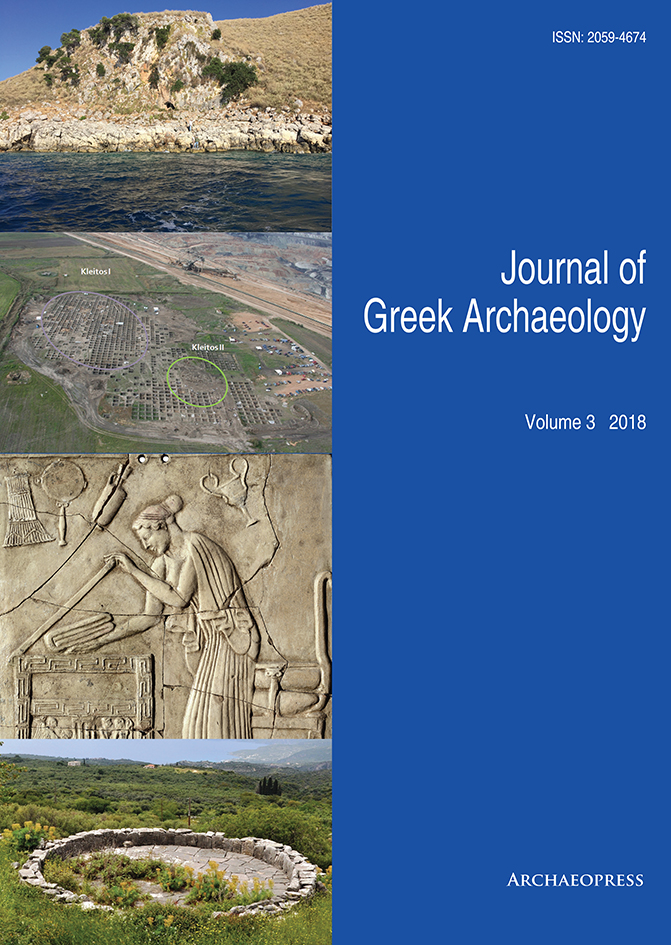Margaretha Kramer-Hajos. Mycenaean Greece and the Aegean World: Palace and Province in the Late Bronze Age.
DOI:
https://doi.org/10.32028/jga.v3i.541Abstract
Diachronic surveys of Mycenaean civilization, our term for the material culture that flourished above all on the central and southern Greek mainland during the six or seven centuries (ca. 1700/1600-1000 BC) we assign to the Late Bronze Age, typically and understandably focus on the regional cores of that culture in the northeast (Argolid and Corinthia) and southwest (Messenia) Peloponnese where it arose and has been most extensively documented. The overview of this culture provided by Margaretha Kramer-Hajos (hereafter MK-H) is refreshingly different in its spatial focus on the Euboean Gulf region of east-central Greece (figs. 1.1-1.2) as well as in its conceptual emphasis on certain aspects of network theory and human agency.
References
Carter, S.W. 2000. ‘The Battle of the Glen’ Revisited: A Gold Signet Ring (CMS I 16) of the Aegean Late Bronze Age in its Full Iconographic Context. Undergraduate Senior Honors thesis, Dartmouth College.
Dietz, S. 1991. The Argolid at the Transition to the Mycenaean Age: Studies in the Chronology and Cultural Development in the Shaft Grave Period. Copenhagen: National Museum of Denmark, Department of Near Eastern and Classical Antiquities.
Drews, R. 2017. Militarism and the Indo-Europeanizing of Europe. London/New York: Routledge.
Gauss, W. and E. Kiriatzi. 2011. Pottery Production and Supply at Bronze Age Kolonna, Aegina: An Integrated Archaeological and Scientific Study of a Ceramic Landscape (Ägina-Kolonna Forschungen und Ergebnisse V). Vienna: Verlag der Österreichischen Akademie der Wissenschaften.
Karkanas, P. and A. Van de Moortel. 2014. Micromorphological analysis of sediments at the Bronze Age site of Mitrou, central Greece: Patterns of floor construction and maintenance. Journal of Archaeological Science 43: 198-213.
Knodell, A.R. 2017. Review of M. Kramer-Hajos, Mycenaean Greece and the Aegean World: Palace and Province in the Late Bronze Age, Bryn Mawr Classical Review 2017.04.13.
Lindblom, M. 2001. Marks and Makers: Appearance, Distribution and Function of Middle and Late Helladic Manufactuers’ Marks on Aeginetan Pottery (Studies in Mediterranean Archaeology 128). Jonsered: P. Åströms Förlag.
Lindblom, M. 2007. Early Mycenaean mortuary meals at Lerna VI with special emphasis on their Aeginetan components, in F. Felten, W. Gauss, and R. Smetana (eds) Middle Helladic Pottery and Synchronisms (Agina-Kolonna Forschungen und Ergebnisse I): 115-135. Vienna: Verlag der Österreichischen Akademie der Wissenschaften.
Lis, B. 2012. Aeginetan cooking pottery in central Greece and its wider perspective. Aρχαιολογικό Έργο Θεσσαλίας και Στερεάς Ελλάδας 4 (2012): 1203-1211.
Mathioudaki, I. 2011. Η ‘Ηπειρωτική Πολύχρωμη’ Κεραμεική στην Ηπειρωτική Ελλάδα και το Αιγαίο. Unpublished Ph.D. dissertation, University of Athens.
Mathioudaki, I. 2015. Τύποι δίχρωμης κεραμεικής απο τη Στερεά Ελλάδα και τη Θεσσαλία της Μέσης και Πρώιμης Ύστερης Εποχής του Χαλκού. Aρχαιολογικό Έργο Θεσσαλίας και Στερεάς Ελλάδας 4(2012): 47-56.
Murray, S.C. 2017a. The Collapse of the Mycenaean Economy: Imports, Trade and Institutions 1300-700 BCE. Cambridge: Cambridge University Press.
Murray, S.C. 2017b. Review of M. Kramer-Hajos, Mycenaean Greece and the Aegean World: Palace and Province in the Late Bronze Age, Cambridge Archaeological Journal 27: 703-704.
Murray, S.C. 2018. Imported Exotica and Mortuary Ritual at Perati in Late Helladic IIIC East Attica. American Journal of Archaeology 122: 33-64.
Pavuk, P. and B. Horejs. 2012. Mittel- und spätbronzezeitliche Keramik Griechenlands. Sammlung Fritz Schachermeyr, Faszikel III (Veröffentlichen der Mykenischen Kommission 31). Vienna: Verlag der Österreichischen Akademie der Wissenschaften.
Rutter, J.B. 1992. Cultural novelties in the Post-palatial Aegean world: Indices of vitality or decline?, in W.A. Ward and M.S. Joukowsky (eds) The 12th Century B.C.: The Crisis Years: 61-78. Dubuque: Kendall/Hunt.
Rutter, J.B. 2014. Reading Post-palatial Mycenaean iconography: Some lessons from Lefkandi, in Y. Galanakis, T. Wilkinson, and J. Bennet (eds) ΑΘΥΡΜΑΤΑ: Critical Essays on the Archaeology of the Eastern Mediterranean in Honour of E. Susan Sherratt: 197-205. Oxford: Archaeopress.
Sakellariou, A. 1964. Corpus der minoischen und mykenischen Siegel I. Die minoischen und mykenischen Siegel des Nationalmuseums in Athen. Berlin: Gebr. Mann Verlag.
Stocker, S.R. and J.L. Davis. 2017. The Combat Agate from the Grave of the Griffin Warrior at Pylos. Hesperia 86: 583-605.
Tsokas, G.N., A. Van de Moortel, P.I. Tsourlos, A. Stampolidis, G. Vargemezis, and E. Zachou. 2012. Geophysical survey as an aid to excavation at Mitrou: A preliminary report. Hesperia 81: 383-432.
Van de Moortel, A. and E. Zachou. 2012. Five years of archaeological excavation at the Bronze Age and Early Iron Age site of Mitrou, East Lokris (2004-2008): Preliminary results. Aρχαιολογικό Έργο Θεσσαλίας και Στερεάς Ελλάδας 4(2012): 1131-1146.
Vonhoff, C. 2008. Darstellungen von Kampf und Krieg in der minoischen und mykenischen Kultur. Rahden: M. Leidorf.






